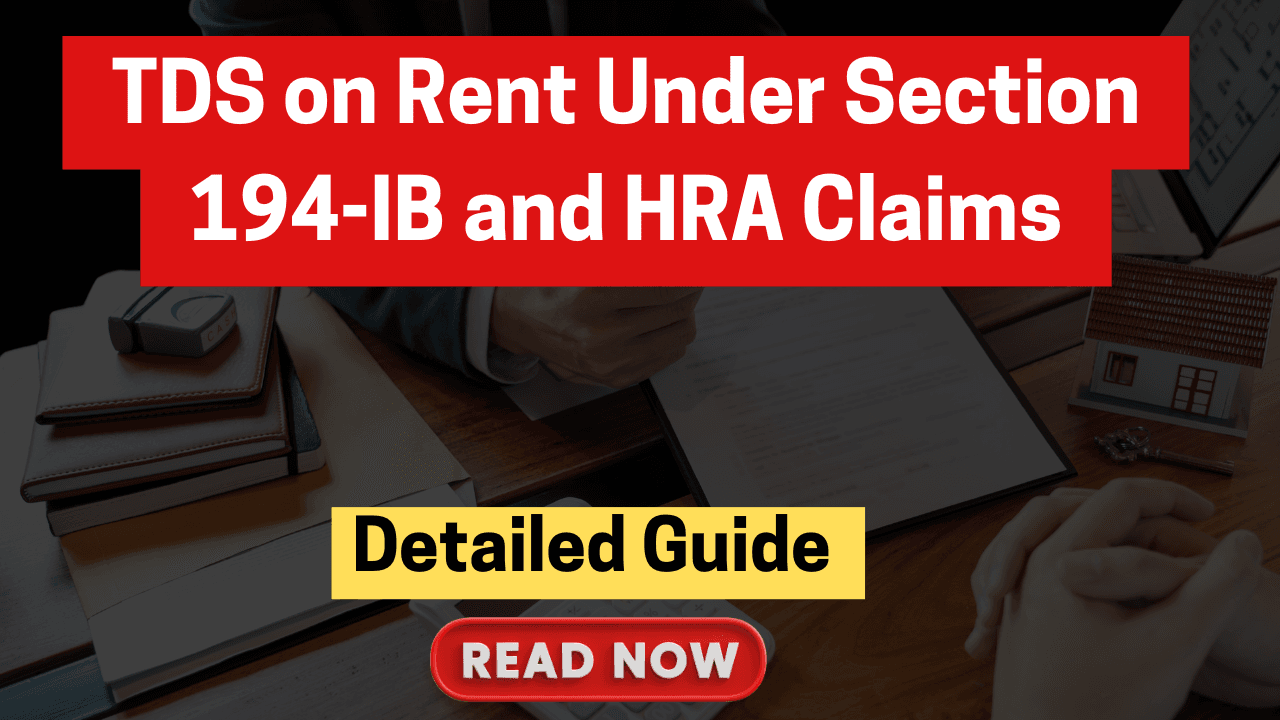TDS on Rent Under Section 194-IB and HRA Claims
TDS on Rent Under Section 194-IB and HRA Claims The Income Tax Department has recently raised concerns about taxpayers claiming House Rent Allowance (HRA) without deducting Tax Deducted at Source (TDS) on rental payments exceeding ₹50,000 per month. Many taxpayers have received SMS and email alerts asking them to verify their HRA claims and correct errors, if any.
In this guide, we’ll explain:
- The applicability of Section 194-IB
- The recent TDS rate change
- Possible penalties and consequences for non-compliance
- How to correct errors using Form 26A
What is Section 194-IB of the Income-tax Act, 1961?
TDS on Rent Under Section 194-IB and HRA Claims Section 194-IB requires any individual or Hindu Undivided Family (HUF) paying rent exceeding ₹50,000 per month to a resident landlord to deduct TDS at 2% on such payments.
Key Conditions Under Section 194-IB:
✅ TDS is deducted at 2% (reduced from 5% starting 1 October 2024).
✅ TDS must be paid in March (for the financial year) or in the last month of tenancy if the property was vacated during the year.
✅ The responsibility to deduct TDS applies even to salaried individuals or non-business taxpayers.
Recent Income Tax Department Campaign
On Sunday, the Income Tax Department sent alerts via SMS and email to individuals who claimed HRA but did not deduct TDS as per Section 194-IB. The messages contained:
- Details of HRA claimed over past years
- A request to verify the claim and rectify any errors
If you’ve received this alert, immediate action is advised to avoid penalties.
Consequences of Non-Compliance
Failure to deduct TDS can lead to the following penalties and repercussions:
- Liability to Deduct and Pay TDS: TDS on Rent Under Section 194-IB and HRA Claims Even if the landlord has already paid tax on rental income, the taxpayer must still pay the missed TDS amount.
- Interest on Non-Deduction: Interest at 1% per month applies from the due date of TDS deduction until the tax is paid.
- Assessee-in-Default: Under Section 201(1A), the taxpayer may be treated as a defaulter.
- Penalty: Penalties up to the amount of TDS that was not deducted can be imposed.
- Prosecution: Under Section 276B, non-compliance may lead to imprisonment for 3 months to 7 years.
- Expense Disallowance: If the taxpayer claimed rent as a business expense, 30% of the rent payment may be disallowed under Section 40(a)(ia).
Relief Provisions: Form 26A
As per Section 201(1), you may avoid penalties if: ✅ The landlord has filed their Income Tax Return (ITR) under Section 139.
✅ The landlord has included the rental income in their ITR and paid taxes on it.
In this case, you must file Form 26A, a Chartered Accountant-certified document confirming these conditions.
https://www.incometax.gov.in/iec/foportal/
Steps to File Form 26A
- Engage a Chartered Accountant to prepare Form 26A.
- The CA will submit Form 26A electronically from both the taxpayer’s and the landlord’s login on the Income Tax Portal.
- Once processed, this will remove the default status, although interest on delayed TDS deduction must still be paid.
Illustration of Interest Calculation
Example:
- Mr. T paid ₹10 lakh rent in FY 2023-24 but missed deducting TDS.
- Ms. X (the landlord) filed her ITR by 31 July 2023 and paid tax on the rental income by 31 July 2024.
Interest Calculation:
- TDS Amount = ₹10 lakh * 5% = ₹50,000
- Interest = ₹50,000 * 1% * 5 months = ₹2,000
Even if Form 26A is filed, Mr. T will still need to pay ₹2,000 as interest.
When to Apply the 2% or 5% TDS Rate?
- For properties vacated before October 2024, apply the 5% TDS rate.
- For ongoing rentals or properties vacated after October 2024, apply the 2% TDS rate.
What If the Landlord Hasn’t Paid Tax on Rent?
If the landlord hasn’t declared rental income or paid taxes, you have two options:
- TDS on Rent Under Section 194-IB and HRA Claims Deduct TDS now and deposit it along with interest and penalties.
- Alternatively, forego your HRA claim and pay tax on the differential taxable salary by filing an updated return.
Conclusion
If you’ve received a notice from the Income Tax Department regarding HRA claims, take immediate action. TDS on Rent Under Section 194-IB and HRA Claims Review your rent payments, verify if TDS was deducted, and file Form 26A if applicable. If TDS was missed, deposit it with interest to avoid further penalties. Taking corrective action now can prevent costly repercussions later.
For further guidance on filing Form 26A, updating returns, or resolving HRA-related issues, consult a qualified tax professional.
For More Information : https://taxgyany.com/

